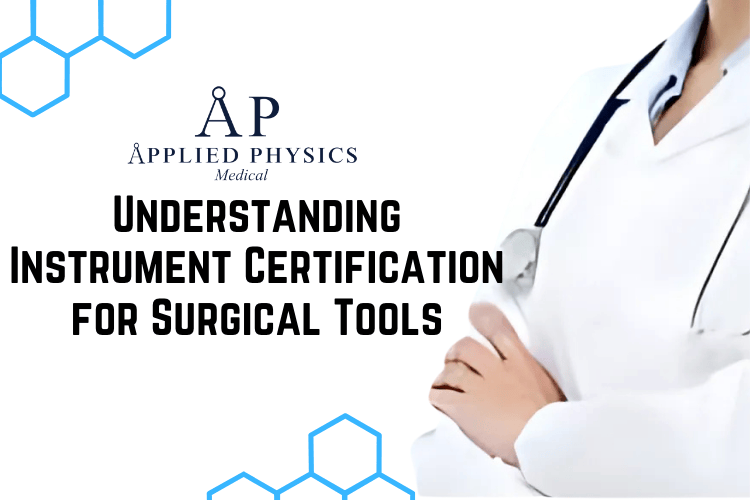Introduction
Instrument certification plays a crucial role in ensuring the safety and efficacy of surgical procedures. Certified surgical tools are designed, manufactured, and tested to meet specific quality and performance standards, which are essential for maintaining the integrity of surgical interventions. The certification process involves rigorous testing, inspection, and validation to guarantee that the instruments meet the necessary criteria for use in medical settings.
Without proper certification, surgical tools may pose significant risks to patients, leading to complications, infections, and suboptimal surgical outcomes. Certification also assures healthcare professionals that the instruments they use have undergone a thorough evaluation and comply with industry standards. This confidence is vital for maintaining the trust and credibility of surgical practices, as well as for upholding the ethical responsibility of healthcare providers to prioritize patient safety and well-being.
In essence, instrument certification serves as a fundamental pillar in the foundation of safe and effective surgical procedures.
Key Takeaways
- Instrument certification is crucial for ensuring the safety and effectiveness of surgical tools used in medical procedures.
- There are different types of certification for surgical tools, and obtaining certification involves meeting specific criteria set by regulatory agencies.
- Using certified surgical instruments can lead to various benefits, including improved patient safety and better surgical outcomes.
- Regulatory agencies play a significant role in setting and enforcing standards for instrument certification to ensure compliance and patient safety.
- Overall, instrument certification has a significant impact on patient safety and the success of surgical procedures, making it a critical aspect of the healthcare industry.
Types of Certification for Surgical Tools
There are various types of certification for surgical tools, each serving distinct purposes in ensuring quality and safety. One common form of certification is the ISO 13485 standard, which specifically pertains to the quality management systems for medical devices. This certification demonstrates that a manufacturer has implemented and maintains a comprehensive quality management system that meets international regulatory requirements.
Additionally, specific regulatory bodies, such as the Food and Drug Administration (FDA) in the United States or the European Conformity (CE) marking in Europe, provide certifications for medical devices, including surgical instruments. These certifications indicate that the instruments have undergone a thorough evaluation and comply with the respective regulatory standards set forth by these agencies. Furthermore, some surgical tools may receive specialized certifications based on their intended use or unique features.
For example, instruments used in minimally invasive surgery may obtain certifications that specifically validate their suitability for such procedures. Overall, the diverse types of certification cater to the specific needs and requirements of different surgical instruments, ensuring comprehensive quality assurance across various medical specialties.
Criteria for Obtaining Instrument Certification
The process of obtaining instrument certification involves adherence to stringent criteria that encompass various aspects of design, manufacturing, testing, and quality control. Manufacturers must demonstrate compliance with specific standards related to material selection, design specifications, manufacturing processes, sterilization methods, and performance testing. These criteria are established to ensure that the instruments are safe, reliable, and effective for their intended use in surgical settings.
Moreover, manufacturers are required to maintain detailed documentation of their processes and procedures to provide transparency and traceability throughout the certification process. This documentation includes records of material traceability, production validation, quality control measures, and post-market surveillance. By meeting these criteria, manufacturers can substantiate the safety and performance of their instruments, ultimately leading to successful certification.
In addition to meeting technical specifications, manufacturers must also adhere to regulatory requirements related to labeling, packaging, and post-market surveillance. These criteria are essential for ensuring that certified instruments are appropriately labeled with essential information for users and patients and that they undergo continuous monitoring for any potential safety concerns or adverse events. Overall, the criteria for obtaining instrument certification encompass a comprehensive framework that prioritizes patient safety and quality assurance in surgical procedures.
Benefits of Using Certified Surgical Instruments
| Benefits of Using Certified Surgical Instruments |
|---|
| 1. Reduced risk of infection |
| 2. Improved patient outcomes |
| 3. Enhanced surgical precision |
| 4. Compliance with regulatory standards |
| 5. Long-term cost savings |
The utilization of certified surgical instruments offers numerous benefits that directly impact patient care and surgical outcomes. Firstly, certified instruments provide healthcare professionals with confidence in the quality and reliability of the tools they use during surgical procedures. This assurance contributes to enhanced precision, efficiency, and overall performance in the operating room, ultimately benefiting patients by reducing the risk of errors or complications.
Furthermore, certified instruments are designed and manufactured to meet strict quality standards, ensuring their durability and longevity. This translates to reduced instrument malfunctions or failures during surgeries, minimizing disruptions and potential risks to patients. Additionally, certified instruments often undergo rigorous testing to validate their ergonomic design and user-friendliness, promoting enhanced usability for surgical teams.
From a patient perspective, the use of certified surgical instruments contributes to improved safety and reduced risks of post-operative complications. By adhering to stringent quality standards, certified instruments minimize the likelihood of adverse events related to instrument performance or material integrity. Ultimately, the benefits of using certified surgical instruments extend beyond the operating room, positively impacting patient outcomes and overall healthcare quality.
Understanding the Role of Regulatory Agencies in Instrument Certification
Regulatory agencies play a pivotal role in overseeing the certification of surgical instruments to ensure compliance with established standards and regulations. These agencies are responsible for evaluating and approving medical devices, including surgical tools, based on their safety, efficacy, and quality. The involvement of regulatory agencies serves as a safeguard to protect patients and healthcare providers from potential risks associated with substandard or unsafe instruments.
In the United States, the Food and Drug Administration (FDA) is a prominent regulatory authority that oversees the approval and regulation of medical devices, including surgical instruments. The FDA evaluates devices through premarket submissions, assessing their safety and effectiveness before granting market clearance or approval. Similarly, in Europe, the European Conformity (CE) marking is a certification that indicates compliance with European Union regulations for medical devices.
Regulatory agencies also play a crucial role in post-market surveillance and monitoring of certified instruments to identify and address any safety concerns or adverse events that may arise after their commercialization. This ongoing oversight ensures that certified instruments continue to meet quality standards and remain safe for use in clinical settings.
Ensuring Compliance with Instrument Certification Standards
Implementing Robust Processes for Instrument Certification
Healthcare facilities and providers must prioritize compliance with instrument certification standards to uphold patient safety and regulatory requirements. This involves implementing robust processes for procuring, inspecting, and maintaining certified surgical instruments within clinical settings. Healthcare facilities should establish clear protocols for verifying the certification status of instruments before their use in surgical procedures.
Education and Training for Healthcare Professionals
Furthermore, ongoing training and education for healthcare professionals are essential to ensure awareness of instrument certification standards and best practices for instrument handling and maintenance. Regular audits and quality assurance measures should be implemented to verify compliance with certification requirements and identify any potential deviations or non-conformities.
Collaboration with Reputable Suppliers and Manufacturers
Collaboration with reputable suppliers and manufacturers who prioritize instrument certification is also crucial for healthcare facilities seeking to maintain a reliable inventory of certified surgical tools. By fostering strong partnerships with trusted suppliers, healthcare providers can access high-quality instruments that meet rigorous certification standards, thereby enhancing patient safety and clinical outcomes.
The Impact of Instrument Certification on Patient Safety and Surgical Outcomes
The impact of instrument certification on patient safety and surgical outcomes cannot be overstated. Certified surgical instruments contribute significantly to reducing the risk of surgical site infections, post-operative complications, and procedural errors. By adhering to stringent quality standards and undergoing thorough validation processes, certified instruments provide a foundation for safe and effective surgical interventions.
Moreover, the use of certified instruments enhances the overall efficiency and precision of surgical procedures, leading to improved outcomes for patients. Reduced instrument malfunctions or failures contribute to smoother operative experiences and minimize disruptions during surgeries. Additionally, certified instruments often feature ergonomic designs that promote ease of use for healthcare professionals, further enhancing procedural efficiency.
Ultimately, instrument certification serves as a cornerstone for maintaining high standards of patient care and upholding the integrity of surgical practices. By prioritizing the use of certified instruments, healthcare providers demonstrate their commitment to ensuring the highest level of safety and quality in surgical interventions, ultimately benefiting patients by minimizing risks and optimizing outcomes.
Conclusion
Instrument certification is an indispensable component of ensuring the safety, efficacy, and quality of surgical procedures. Through adherence to rigorous standards and regulatory oversight, certified surgical instruments play a vital role in safeguarding patient well-being and enhancing clinical outcomes. Healthcare providers must prioritize compliance with certification requirements while recognizing the significant impact that certified instruments have on advancing patient safety in surgical settings.


